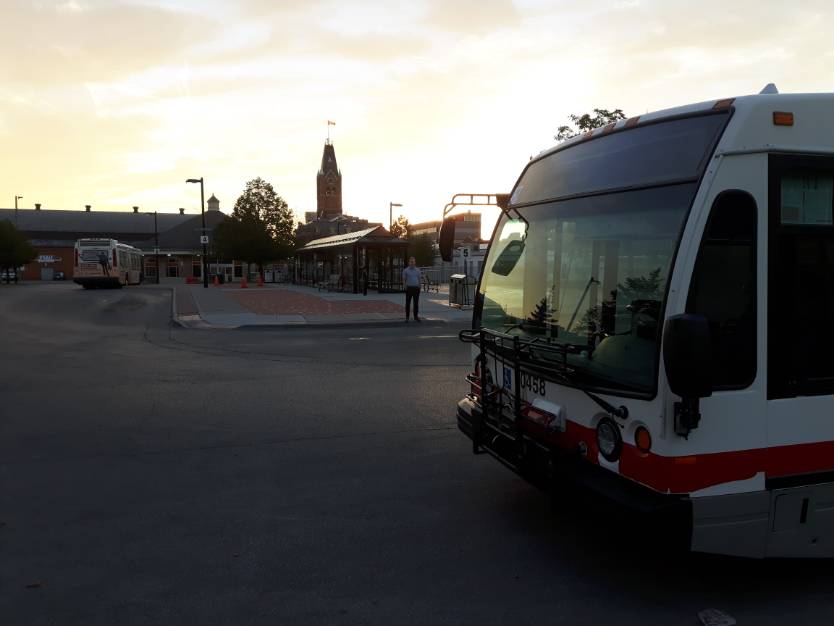Pantonium is now in the midst of deploying our newest on-demand transit technology to a public transit agency in Canada. So far it has been running since September 17, 2018, ridership has doubled in two weeks, and the initial pilot is expected to last until January 2019. Here is a video containing interviews of citizens of Belleville about their hopes and opinions regarding the new service. So far Pantonium has learned a lot about how our technology fits into a public transit operation and how more places could adopt an on-demand service. Here are four major lessons from our ongoing pilot for transit and technology enthusiasts to consider:
- Know when and where on-demand service will be most useful. When it comes to on-demand transit the knee-jerk negative reaction by people is to say “that will not work here,” this criticism is sometimes correct. For example, on-demand transit would not be a good option in a downtown core of a city during rush hour. Toronto, New York, Los Angeles or pretty much any major metropolitan core have so much demand that they need massive capacity to move people, that means high frequency, fixed route vehicles, like trains or large buses. This is why Uber, is still losing massive amounts of money and is in fact increasing congestion in major cities, because forcing on-demand everywhere will not work. Many public transit industry veterans can attest to the story of dial-a-ride’s death from success. Where a transit agency used to offer a dial-a-ride service, which is a phone based on-demand transit, and had to convert it to fixed route after demand increased. There are however many cases where it does not make sense to run fixed route buses, that includes night time service and low-density areas. For example the TCRP has found on-demand/flexible services working in population densities that range from very rural areas with 5-10 people per square mile, while others that are suburban, with 1,000-2,000 inhabitants per square mile work as well. Belleville, where Pantonium is operating has a density of roughly 500 people per square mile.
- The technology must have flexibility and robustness to handle all cases of riders requesting transportation. Not everyone owns a smartphone, not everyone wants to call a dispatcher, not everyone knows about the pilot or service changes. Therefore Pantonium’s system has the flexibility to take riders on an ad hoc basis, from any stop, then allow drivers to input these ad hoc riders into the system, from terminals on the bus, then those trips are automatically scheduled. This is important because public transit has an obligation to provide service to everyone. And when it comes to technology, not everyone is as comfortable interfacing with it and that includes drivers, riders and administrators. Rather than scorching all fixed routes and forcing drivers to only pick up people who order via the portal, Pantonium’s approach is to change operations as little as possible, but to allow an additional way for people to engage with the transit agency.
- Automation is critical for both routing and on-boarding. Belleville Transit is deploying this service for its night time routes, and during those hours there are no available dispatchers. Unlike every other demand-response system so far deployed by public transit, this service runs autonomously thanks to Pantonium’s Everrun platform. The system is capable of making on the fly decisions about schedules and routes without human supervision. This is key for scaling a service to control many vehicles and handle many trips, rather than hiring more and more dispatchers the system only needs more computational power to scale. When it comes to on-boarding riders, drivers do not have to do any extra work, riders merely scan a uniquely generated QR code to identify themselves to the system when the get on and off the bus. This process will help public transits set up automated payments and also prepare for a future of driverless vehicles.
- Use the infrastructure you’ve already got. There are 130,000 transit buses operating in North America, Belleville has 14, which is still a considerable investment in capital resources, there are also hundreds of bus stops that already have been built and paid for and that is the case for every agency. Rather than throwing that all away and doing something like a door-to-door service with Ubers or Lyfts, the more sustainable option is to apply a layer of technology to existing infrastructure to improve efficiency and public access. This way we can experiment with new service features, without eroding the capabilities of transit agencies.
We will keep you posted on news from the pilot. Do you think your area could use on-demand transit? Let us know in the comments.




